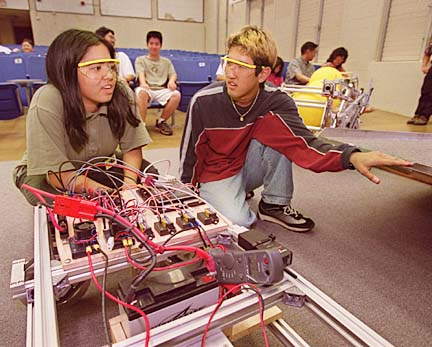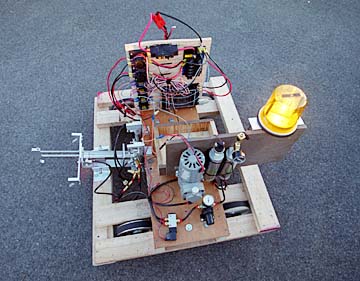Advertisement - Click to support our sponsors.


PEOPLE who have nightmares about assembling their kids' toys with the hieroglyphics called "instructions" should stay away from Milton Lau's class at McKinley High School.
It's not C3PO. It's not even R2D2.
But McKinley High School Tigers are ready
to take on the nation with Naia IIMcKinley High Web site
By Pat Gee
Star-BulletinLau and 13 students are building a robot with "140 pounds of junk" and no instructions.
The students volunteered to be in the extracurricular class. Five of them are girls, and some do not even belong to Lau's shop class.
The robot will be entered in a national contest, and the idea behind it is to inspire students to go into space, science and engineering. The McKinley robot will compete with 499 others built in high schools across the nation, including those entered by Waialua and Waipahu.

Last year, in a David-and-Goliath battle in the western regional division, McKinley came in second to a robot sponsored by Ford Motor Co. The Ford robot must have cost about $100,000 to build, Lau said, compared with McKinley's $10,000 entry -- the same as this year's.Teams sponsored by General Motors and Ford have all their expenses paid, including air fare and meals. The McKinley team has had to hold fund-raisers to pay for their expenses, but they learned that good teamwork is worth more than money.
Facing robots that cost hundreds of thousands of dollars and "could do just about anything," McKinley's robot last year "wasn't the best," Lau conceded. But it was "how the kids played the game," using good strategy, communication and teamwork, that won them second prize, he said.
Hawaiian Electric Co. is contributing $5,000 to the cause for the second year, and a few of its electrical engineers are volunteering their expertise.
Linking virtual, real worlds
Lau called on his friends from Heco and RHT Enterprise, a machinist company, to help his students, who are highly computer literate but challenged when it comes to hands-on mechanical skills.The group, Kika Mana (meaning "tiger power" after the school's mascot), had only six weeks according to contest rules to complete the robot, using 140 pounds of nuts, bolts, gears and other automotive parts sent by the national contest sponsor in two wooden crates. It must be ready to be FedEx'd to California by tomorrow. The students were to hold a press conference today to show off what their robot can do.
Their robot does not look like a mechanical human -- nor will it have the short and stubby can-like shape of R2D2 of "Star Wars" fame. They named it Naia ("dolphin") II. Looking nothing like its namesake, the robot is a boxy aluminum frame on wheels, carrying a conglomeration of wires and metal parts, including pneumatic cylinders, pistons, various motors and a flashing light.
The contest, to be held at San Jose State University, is sponsored by FIRST (For Inspiration and Recognition of Science and Technology) and run by NASA. Competition will take place March 23 and 24, but the team will leave March 18 for 10 days of educational field trips.
"It's exciting to see their eyes light up, that something they conceived is actually working. They put in the time because it's so rewarding," Lau said. "It ties the virtual world with the real world."

The students not only have to build a robot, they have to program and control its movements to score goals in a game, and coordinate its action with three other robots entered by high school teams.The students are not doing anything the easy way. To score the most points, they are going to make their robot balance on a teeter-totter as it hangs onto two goals (which look like PVC cages) hooked on either side. By itself, it would make a good circus trick. But add the other robots to the equation, and it becomes a three-ring circus.
Seniors Elaine Owens and Chris Orimoto, returnees from last year, are in charge of programming the robot by computer and controlling its movements with a joystick. They say it will be harder this year with new time requirements, but raise a quiet cheer from their classmates when they successfully maneuver the robot to balance on the teeter-totter.
Sophomore Li-Ann Dela Vega, who wants to be a computer graphic designer, "didn't even know what a screwdriver looked like" when she first joined the team in January. "Now I'm using expensive tools," such as power drills, with confidence.
The "hands-on experience" and the long hours working with engineers have given her team a good idea about what it means to be an engineer, a field many want to go into, Dela Vega said. She said she joined the team because she has always been fascinated by robots.
Alan Ing, an electrical engineer with Hawaiian Electric, has been working on the design and construction of the robot from 5 to 11 p.m. weekdays, and 12 hours a day on weekends.
"It's something I've always wanted to do, build a robot," he said. "I like showing the kids how to take an idea and bring it into something real. Kids today don't do a lot with their hands. They don't fix or make things," as he did when he was their age, Ing said.
'Life lessons' being learned
Besides, "How often do they get to play with a several-thousand-dollar toy, something they built themselves?" he asked.Lau said the biggest challenge facing the team is geographic. It takes three or four days for parts to be shipped to Hawaii, whereas teams on the mainland only have to wait a day.
In addition to Ing, volunteers include Enrique Che and Tom Battisto of Heco, Steven Asaumi of the Department of the Navy, and Roy Tom and Brent Hirata of RHT Enterprise.
Che said the project has taught the students "life lessons," such as sharing their talents with others for the good of the whole, and that "nothing in life is free," since they had to raise the money for air fare and expenses.
In the end, even if the Tigers win, it is the participation that will count most. They will not be going to the national event even if they win the regional contest because they do not have the money and cannot miss so much school, Lau said.